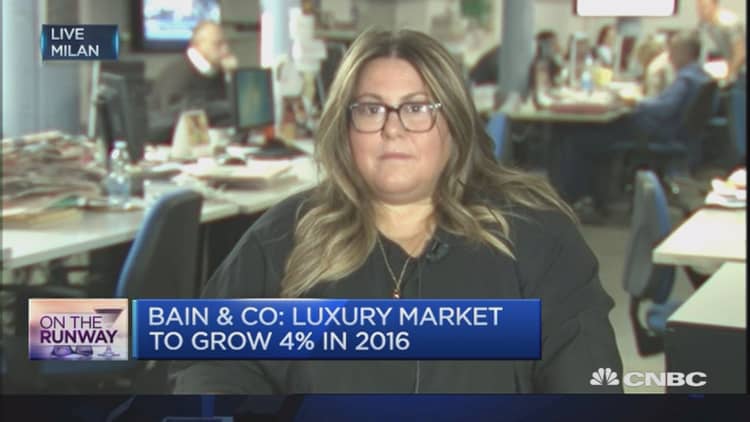
Growth in the luxury private jet market is set to dip by 5 percent while luxury yachts have a zero growth outlook for 2016 as consumers are increasingly preferring to spend on experiences than playthings, according to the latest Bain Luxury Study, which forecasts a 4 percent rate of growth in 2016 for the overall industry.
The annual review of the global luxury market shows lifestyle outlays on items such as hotel stays, cruises and edible experiences holding up more strongly than the spend allocated towards pricey goods.
According to Claudia D'Arpizio, a Partner at Bain & Co. and the lead author of the report, which was released late last week, the sales of smaller luxury items, seen down by 1 percent in aggregate, are also struggling.
"In particular, the personal luxury goods market is suffering a little bit. Fashion, bags, shoes, jewellery and watches to be precise," she told CNBC.
One exception to the weakness in luxury goods sales is the car market which is seen to have the strongest annual growth of the 10 categories at 8 percent. However, this is a sharp slowdown from the previous year's 15 percent growth rate, largely due to a depressed U.S. market and a deceleration in China.
Thematically, the key trend to watch in this space is the increasing collaboration between luxury automotive manufacturers and Silicon Valley as we zoom ever closer to a future of driverless cars.
A raft of challenges has hit hoteliers from terrorism fears in Europe to a burgeoning battle for established luxury giants to retain the interest of a younger clientele increasingly attracted by more innovative and boutique offerings. Despite this, the sector is set to manage positive albeit slowing growth this year.
Meanwhile, the pursuit of less mainstream experiences has carried over to the luxury cruise industry, where customers have shown a hankering for exploring less trodden and further flung destinations as well as more niche itineraries, such as river cruising, a sub-segment currently most established in Europe.
One bracket of goods which has held up this year is the sale of wine and spirits, with the "premiumization" of cocktails boosting the market to a predicted annual growth rate of 4 percent this year. A growing preference in China for Western alcohol brands over local ones has given the former a potent shot in the arm to the detriment of domestic manufacturers.
And China's influence on the market cannot be underestimated with much of the deceleration in the global market blamed on continued weakness from its consumers. While domestic spending has picked up, the broader market is suffering from the pullback of Chinese tourists.
"Not all the consumption that was happening outside China has been repatriated into China so overall the global consumption of Chinese consumers is decreasing," said D'Arpizio.
Other countries are facing their own set of issues, largely driven by a turbulent year for geopolitics, with confidence among U.S. consumers hit by election uncertainty, Middle Eastern and Russian buyers affected by continued oil price volatility and France and Germany most afflicted among the European nations by fears over terrorism.
The sharp fall in sterling following the EU referendum might have given a temporary boost to sterling and the appetite for buying luxury in the U.K. but the tailwind offered to foreign buyers is anticipated to be short-lived until prices are adjusted and inflation picks up.
A clear trend emerging from the report is the bifurcation of the luxury market. Entry-level luxury, helped by the growth of e-commerce and the rise of emerging market middle classes, is seen as a key area of sector growth. Meanwhile, the impetus for luxury purveyors to seize on the desire for differentiated, personalized and unique offerings is essential to keep attracting more mature and more affluent customers.
In the words of D'Arpizio, "For now it is really a question of stimulating the market and getting consumer back in the stores and really innovating the value proposition and product to be really relevant to them."


